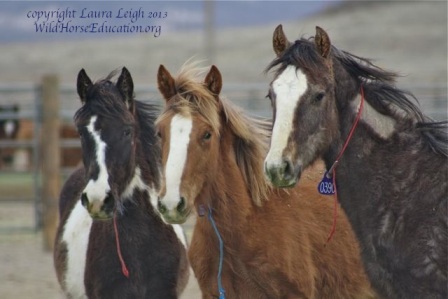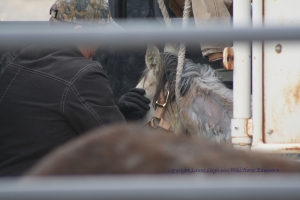At Wild Horse Education we get many requests to read freezemarks on wild horses people find at auction or posted for sale. Many of these animals do not have papers or even an oral history about where and when that horse was captured. But the mark that the Bureau of Land Management places on the left side of the wild horse or burro’s neck is a key to unlock that history.
EDITED: In 2020 BLM began to change the way they freezemark. BLM now uses a “facility code,” not an HMA code. If your horse or burro was captured in the last couple of years, we cannot read the mark and tell you where your horse is from. You need to contact BLM. The code only tells you WHERE a horse was branded. Example: A Nevada horse might be branded in Utah. A California horse might be branded in NV.
In several instances people have sent us a freezemark and we have been able to provide them the history of the HMA and even a photo of that animal during or after capture.
The best way to know the history of your mustang is to contact BLM and provide a clear photo of the mark. They should be able to give you an approximate capture date, age and location your wild horse is from. They may even be able to provide you with a new title for wild horses that have been adopted or sold without title transfer from owner to owner.
What it is?
The chosen method of the BLM to mark a horse or burro as a wild horse managed on Federally protected land is “freezebranding.” A “freezing” branding iron is used to mark the hide of an animal. Freeze branding uses extreme cold to kill the cells in the animal’s skin that produce pigmentation (color). A freeze branded animal will have white hair where the freeze branding iron touched the skin. A permanent mark, freeze branding a horse (or cow or other animal) is done for identification purposes.
How is it done?
As feezemarking kills pigmentation in the skin that colors any hair growth so the area must first be shaved.
Next the area to be branded is soaked with alcohol for two reasons; it disinfects and alcohol itself is an evaporant (coolant).
To make the branding iron cold BLM uses liquid nitrogen (other substances like dry ice and alcohol may be used by ranchers to mark cattle).
BLM sets the branding iron with a series of alpha numeric segments (will be explained later) that identify the BLM, range removed and 4 digit ID code (tag number) of the animal. It is placed in the liquid nitrogen.
The branding iron is removed from the nitrogen and placed on the animals skin and held there for a few moments. If the animal moves it may require a second branding.
BLM usually performs this procedure as vaccinations and worming is done at the short-term holding facility.
In about three months time the hair has grown back with the branded areas white. In order to read many of the brands accurately you must re-shave the area. This is particularly true of animals that have light hair or heavy coats.
How to read a freezemark
It’s actually pretty easy to do.
The large U shaped mark is the BLM code. The next two marks (one on top of the other) is the estimated year of the horses birth. The next six marks is the registration code. The registration code is made up of two digits identifying the region taken and the next four are the “tag number.”
“Sale Authority” horses, those that BLM has said are too old or have proven “unadoptable” get an additional large “US” symbol to ID them as “sale.” (Title transfers immediately, no waiting period).
But that’s just a bunch of numbers, what does it mean?
The large “U” looking thing means the horse was managed under the Wild Free Roaming Horse and Burro Act on BLM managed federal land.
The birth year gives you the animals estimated age.
The first two digits of the registration code may be the most important to the history of the animal. This two digits tell you where your horse is from. With the addition of the next four digits you can determine when your horse was removed from the range.
The chart to the left gives you a state by state fast overview and is on the BLM website. This chart can tell you quickly what state a horse is from. However you can get much “closer” than that by looking at BLM range codes.
For example here are a few areas in Nevada people are most familiar with (these numbers are the last three digits of a “herd code”):
Antelope, 401 Antelope Valley, 107 Bald Mountain,603 Black Rock East, 209 Black Rock West,227 Buck and Bald,403 Butte,407 Calico Mountains,222 Callaghan,604 Diamond Hills North,104 Diamond Hills South,412 Dogskins,302 Flanigan,301 Fish Creek,622 Granite Peak,303 Jackson Mountain,208 Jakes Wash,408 Lahontan,306 Little Humbolt,102 Little Owyhee,200 Maverick Medicine,105 Owyhee,101 Pine Nut,305 Roberts Mountain,607 Rocky Hills,605 Silver Peak,623 Snowstorm,201 Spruce/Pequop,109 Stone Cabin,618 Wassuk,312
These digits can assist you in narrowing down the search for a freezebranded wild horse or burros “history.” EXAMPLE: If your freezebrand reads an animal is 4 years old and from a “60” coded area in Nevada you can look at the Herds with a “60” code and see what areas had a roundup in the last 4 years. Yes we know that is getting harder and harder to do as so many areas are now being rounded up as removals escalate all over the west in the last 5 years.
NOTE: We will expand this page further as time allows but hope this is a good “beginning” place to track the history of a mustang you meet.
This video was done at processing over three years ago when BLM used to give Laura Leigh access to such things. Leigh has not been able to view processing at this facility since 2010.






You must be logged in to post a comment.